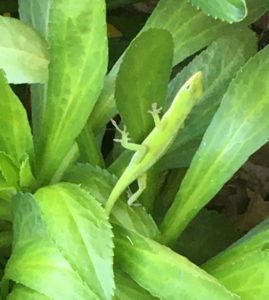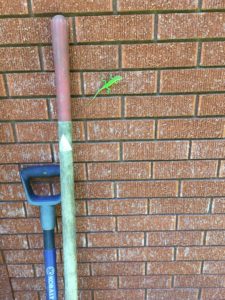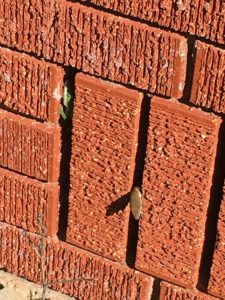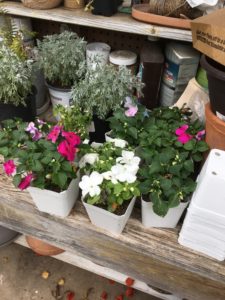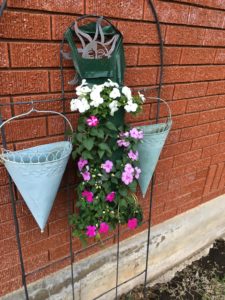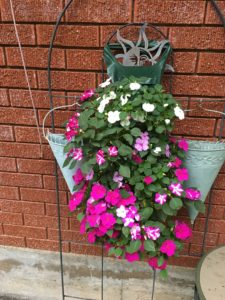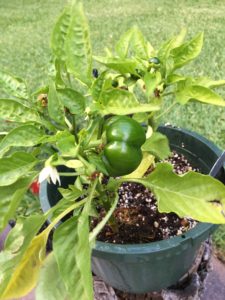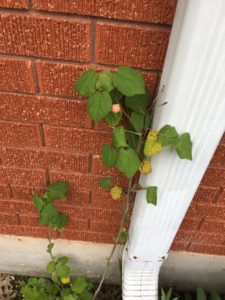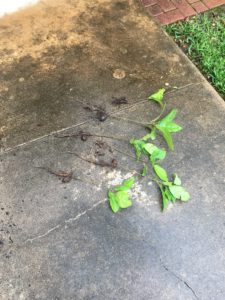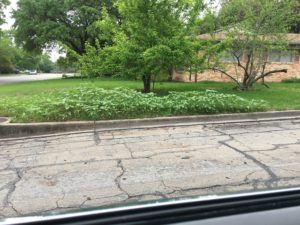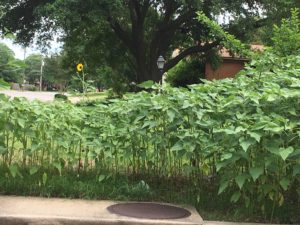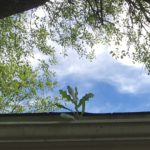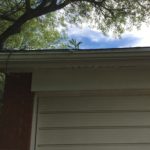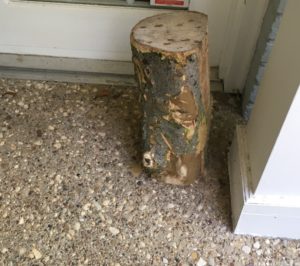 Here’s the log I ran over a couple of weeks ago. A friend of mine has a husband whose hobby is creating lovely wooden items. When she saw that blog post (and saw the log), she said that maybe her husband could make something. I said, “It’s hackberry,” and she said, “He likes working with hackberry!” Here it is, sitting on their porch. After it dries out and he has a look at it, I might be getting an attractive reminder of the incident.
Here’s the log I ran over a couple of weeks ago. A friend of mine has a husband whose hobby is creating lovely wooden items. When she saw that blog post (and saw the log), she said that maybe her husband could make something. I said, “It’s hackberry,” and she said, “He likes working with hackberry!” Here it is, sitting on their porch. After it dries out and he has a look at it, I might be getting an attractive reminder of the incident.
- For several years, we have had an anole crawling around on the brick. We do not know if this is the same one. But here is the first time I saw him, early in April, on the daisies at the side of the house.
- Basking on the bricks in the morning sun.
- A couple of years ago, a brown one turned up. I guess they hibernate under the house. This is where we often see them–in this vented brick at the bottom of the wall, on the side that gets the most sun.
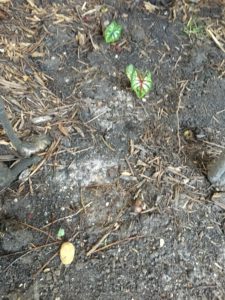
The miracle plants. Last week, there was one tiny Caladium plant, doing its best to sprout and grow. That’s it at the top of the photo. Just below that plant, are three more Caladiums. You can clearly see that they are two different varieties. And, yes, those three shouldn’t be so close together, but let’s just think of them as being supportive of each other, in these trying times of a gardener who didn’t make particularly good choices about arranging things. AND, down at the bottom, next to the rock that I put in place so you might actually be able to see the thing, is another one, sprouting, too. I have hope. Who knows what might happen, now that the temperature’s warming. There might only be these five, but there might be fifteen. Or somewhere in between.
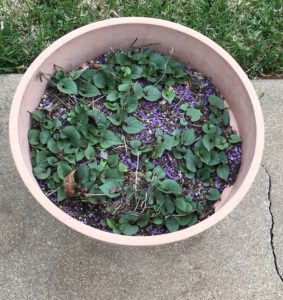
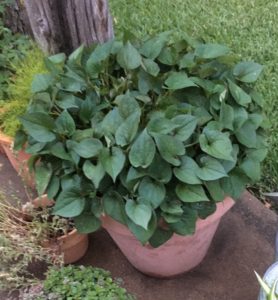 This is an amazing plant, and I don’t even know what it’s name is. Several years ago, I got a piece of it from David’s Aunt Frances. She said it was easy to care for and sturdy. I put it in this pot and it grew well all spring and summer and into the fall. With the first freeze, it was gone. It was in this large container and really heavy because of the weight of the container plus all the soil that was there. In the spring, we made another trip to visit David’s parents, stopping mid-way to spend the night again with Frances (in Memphis) and to take her with us on to Tennessee. I asked if I could please have another cutting of this nice plant, because it had frozen away in the winter. She looked perplexed. She said that, yes, it died back in the winter, but it always came back. I had emptied and cleaned out the pot, getting it ready, I’d hoped, for some nice, new, sturdy cuttings. She did, graciously, give me some more, but assured me that it would come back, after the cold winter. And, indeed, it did. And has, all these years later.
This is an amazing plant, and I don’t even know what it’s name is. Several years ago, I got a piece of it from David’s Aunt Frances. She said it was easy to care for and sturdy. I put it in this pot and it grew well all spring and summer and into the fall. With the first freeze, it was gone. It was in this large container and really heavy because of the weight of the container plus all the soil that was there. In the spring, we made another trip to visit David’s parents, stopping mid-way to spend the night again with Frances (in Memphis) and to take her with us on to Tennessee. I asked if I could please have another cutting of this nice plant, because it had frozen away in the winter. She looked perplexed. She said that, yes, it died back in the winter, but it always came back. I had emptied and cleaned out the pot, getting it ready, I’d hoped, for some nice, new, sturdy cuttings. She did, graciously, give me some more, but assured me that it would come back, after the cold winter. And, indeed, it did. And has, all these years later.
- The impatiens when I brought them home from the nursery.
- The impatiens when I first put them in the hanging bag.
- The impatiens now.
And, yeah, I need to decide what to put in those cone-shaped things. Something trailing.
- The first green pepper. They’re always small, and I’m supposing it is because I plant them in a pot, instead of the garden. I’ve not had any luck with vegetables in the garden. Not enough sun, I think.
- The first flower on the Turk’s Cap plants
- From the front flower bed: four pecan trees and one oak tree, compliments of the local squirrels.
Around the corner from us, on the path I always take to get from the neighborhood to the shopping areas, I see these plants. I don’t know if someone, years ago, purposely sowed these plants, or if folks were sitting around on the ground, enjoying munching on sunflower seeds, and some of them landed, unshelled, in the grass. However it happened, sunflowers grew. And, over time, they kept on reseeding and growing. Now, it’s one of the first signs of springtime, when the sunflowers begin to grow. Last summer, when Peter came to visit, he’d just been to a nature camp, and he was telling us what he’d learned about sunflowers. We took a walk around the corner, to see the wall of sunflowers. He explained all the parts of the sunflowers and how they grew and about their leaves and about their petals. As soon as they began to sprout this year, I took photos of them. Then, later, the growing plants.
Just today, May 7, as I rounded the corner, I saw the very first sunflower. Of course, I took a picture. As I was driving away, I saw a woman standing at the side door. I stopped and gestured for her to come. As she walked toward me, I called out for her to not come too close, but I explained how my grandson and I enjoyed seeing their flowers and how I was excited for the first one and I had taken a picture to show him. “Your first sunflower this year,” I said. And she shook her head and shrugged. Ah. Not an English speaker. Then, a younger woman came out and I said the same things to her, and I’m finally understanding that she didn’t have much English herself. But, I gestured, pointed, smiled and said, “first sunflower” several times. And then they pointed and smiled. And we all three enjoyed the moment.
- In case you doubt what a fabulous gardener I am, Here is a strong, sturdy plant, thriving at our house.
- Its a dandelion. In the roof gutter.
Careful planning puts you ahead in the long run; hurry and scurry puts you further behind.
Proverbs 21:5 (The Message Translation)
The plans of the diligent lead surely to abundance, but everyone who is hasty comes only to want.
Proverbs 21:5 (New Revised Standard Version)
A well-thought-out plan will work to your advantage, but hasty actions will cost you dearly.
Proverbs 21:5 (The Voice Translation)
I would love to be able to say that all my gardening/yard work/landscape plans are well-thought-out. I often see an attractive plant and think I could grow that. I am often wrong. I’m getting better. Every year, I make fewer mistakes.

